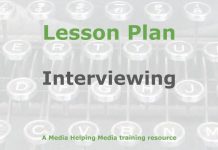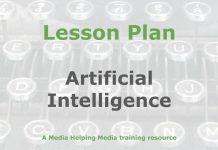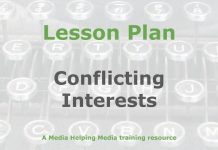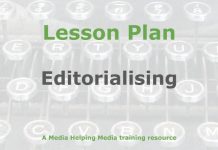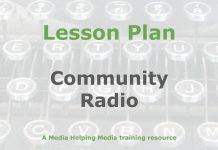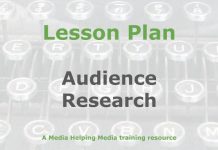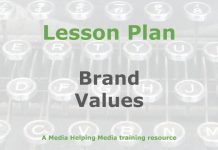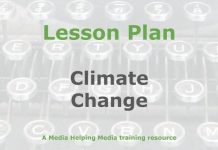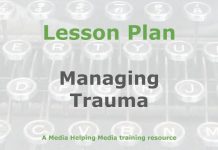 This lesson plan teaches students about the six essential questions – What? Why? When? How? Where? and Who? – which which journalists should consider when producing a piece of journalism.
This lesson plan teaches students about the six essential questions – What? Why? When? How? Where? and Who? – which which journalists should consider when producing a piece of journalism.
It’s based on the article ‘The questions every journalist should ask‘ which we recommend trainers read before adapting this lesson plan for your own needs.
Learning objective
Students will formulate and prioritise the six essential questions – What, Why, When, How, Where, and Who – when researching a news story, demonstrating strategic omission and emphasis based on the story’s context. They will evaluate the significance of each question to construct a compelling and informative narrative.
- Student-facing objective: By the end of this lesson the student will be able to ask the right questions for a news story and decide which ones are most important to tell a strong story.
- Standards: Students will be able to ask the right questions when researching a news story.
Learning activities
Warm-up
Display the six essential questions: What, Why, When, How, Where, and Who. Ask students to jot down a brief example of a news story or event they know. Then, in pairs, have them discuss which of the six questions they think would be most important to ask about their chosen story and why. Encourage them to consider the context and potential impact of each question. After a few minutes, invite a few pairs to share their thoughts with the class.
Direct instruction
- Introduction to the six questions: Begin by explaining the significance of the six questions – What, Why, When, How, Where, and Who – in journalism. Use an example, such as a recent news event, to illustrate how these questions provide a framework for comprehensive reporting. Discuss how each question contributes to understanding the story’s context and depth.
- Strategic omission and prioritisation: Introduce the concept of strategic omission. Explain that not all questions need to be answered in every story. Use a case study, such as a local event, to demonstrate how prioritising certain questions over others can enhance the narrative. Discuss how journalists decide which questions are most relevant based on the story’s context and audience needs.
- Interplay and narrative structure: Discuss how the interplay of questions shapes the narrative. Use an example, such as a feature article, to show how starting with a compelling “what” or “who” can hook the reader. Explain the pyramid structure, where the most critical information is presented first, followed by supporting details. Highlight the importance of the “why” in providing context and depth, ensuring the story resonates with the audience.
Guided practice
- Think, pair, share
- Think: Ask students to individually consider a recent news story and identify which of the six questions – What, Why, When, How, Where, Who – they believe is most crucial for that story. Have them jot down their thoughts.
- Pair: Have students pair up to discuss their chosen question and reasoning. Encourage them to consider the context and potential impact of each question.
- Share: Invite pairs to share their insights with the class. Facilitate a brief discussion on how different questions can shape the narrative of the same story.
- Co-craft questions:
- Present a brief news story or scenario to the class.
- In small groups, have students co-craft a set of questions using the six essential questions. Encourage them to prioritise and strategically omit questions based on the story’s context.
- Ask each group to present their crafted questions and explain their prioritisation choices.
- Compare and connect:
- Provide students with two different news articles on the same topic.
- In pairs, have students compare how each article uses the six questions. Identify which questions are emphasised or omitted and discuss the impact on the narrative.
- Facilitate a class discussion on the differences and how they affect the reader’s understanding.
- Notice and wonder:
- Display a headline or lead from a news story.
- Ask students to note what questions are immediately answered and which are left open. Have them wonder about the unanswered questions and their significance.
- Discuss as a class how these unanswered questions might be addressed in the rest of the article.
- Poll the class:
- Present a controversial or complex news topic.
- Conduct a class poll on which of the six questions students think is most important to explore for this topic.
- Discuss the results and explore why certain questions might be prioritized over others, considering audience and context.
Independent practice
- Assign students a news story or event. Have them individually write a brief analysis using the six questions: What, Why, When, How, Where, and Who.
- Instruct students to prioritise the questions based on the story’s context, strategically omitting less relevant ones.
- Ask students to justify their prioritisation and omission choices in a short paragraph.
Assignment
Questions:
- Which of the six questions (What, Why, When, How, Where, Who) did you find most challenging to prioritise today, and why?
- How does strategic omission enhance a news story’s narrative?
- What’s one question you still have from today’s lesson?
Suggested answers:
- Suggested answer to Question 1: Students may find “Why” challenging due to its complexity and the depth of context it requires.
- Suggested answer to Question 2: Strategic omission focuses the narrative, making it more engaging by highlighting the most relevant aspects.
Teacher resources
Differentiation guide
- Advanced learners: Encourage deeper analysis by having students explore how different media (e.g., print, online, broadcast) might prioritise the six questions differently. Challenge them to create a multimedia presentation that demonstrates these differences.
- Striving learners: Simplify the task by focusing on just three questions (e.g., What, Why, Who) initially. Provide sentence starters or question prompts to guide their thinking. Use visual aids or graphic organisers to help them structure their analysis.
- General strategies: Use peer support by pairing advanced learners with striving learners for collaborative activities. Offer additional examples and practice opportunities for those needing reinforcement. Adjust the pace of the lesson to ensure comprehension and engagement for all students.
- Recommended reading: We recommend trainers read the article ‘The questions every journalist should ask‘ before adapting this lesson plan for your own needs.
Required materials
- Whiteboard and markers
- Projector and screen
- Printed copies of two different news articles on the same topic
- Paper and pens for student notes
- Access to online news sources (optional)
Lesson summary
- Warm-up
- Direct instruction
- Guided practice
- Independent practice
- Assignment
The free teaching tools at the Khan Academy were used in the production of this lesson plan.
Related article
